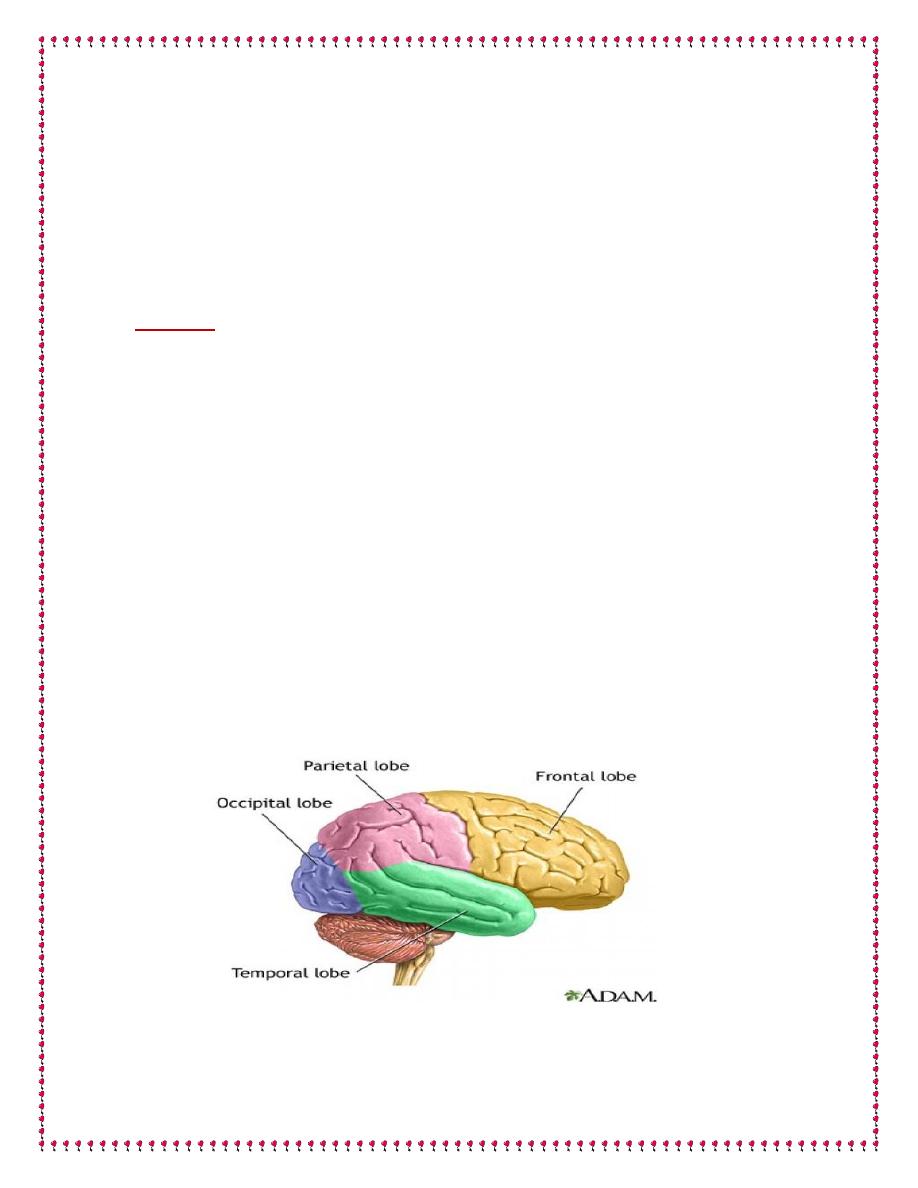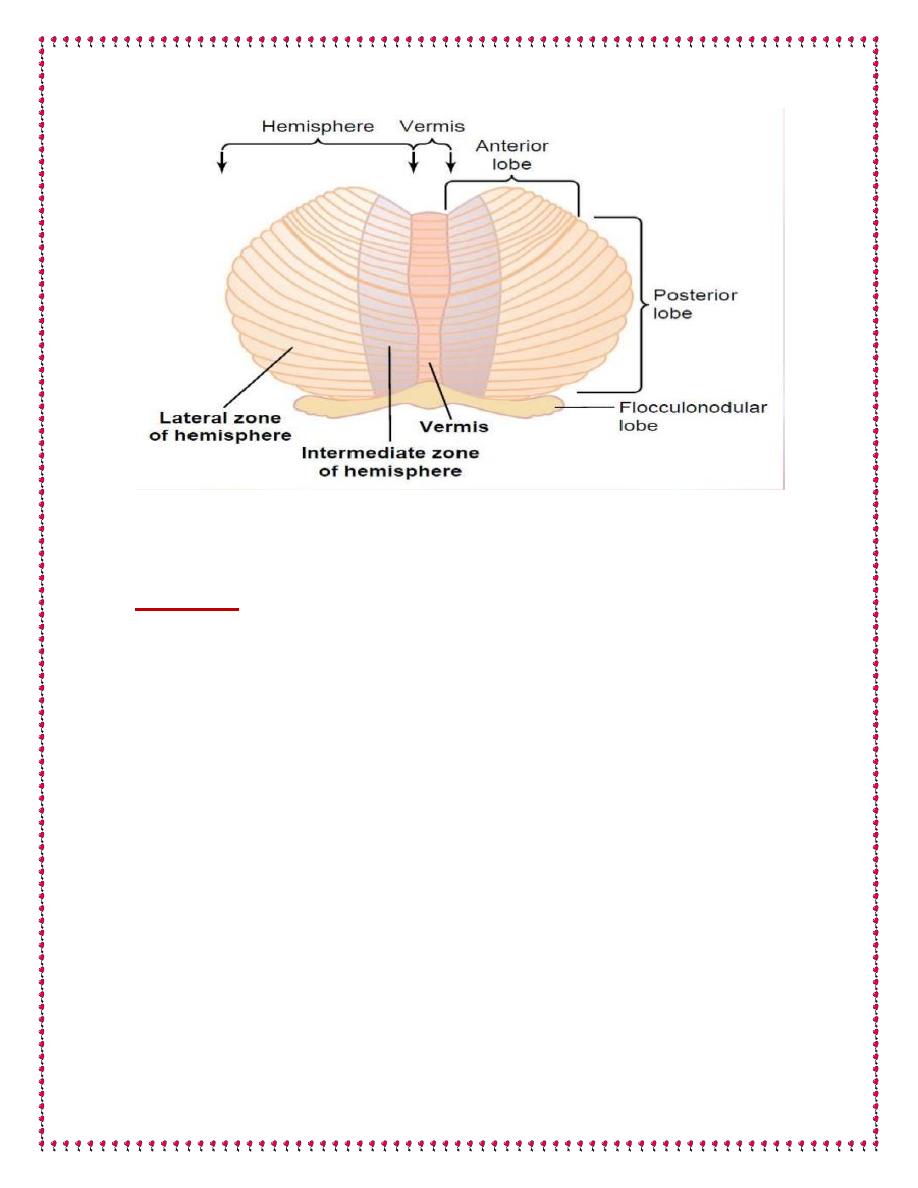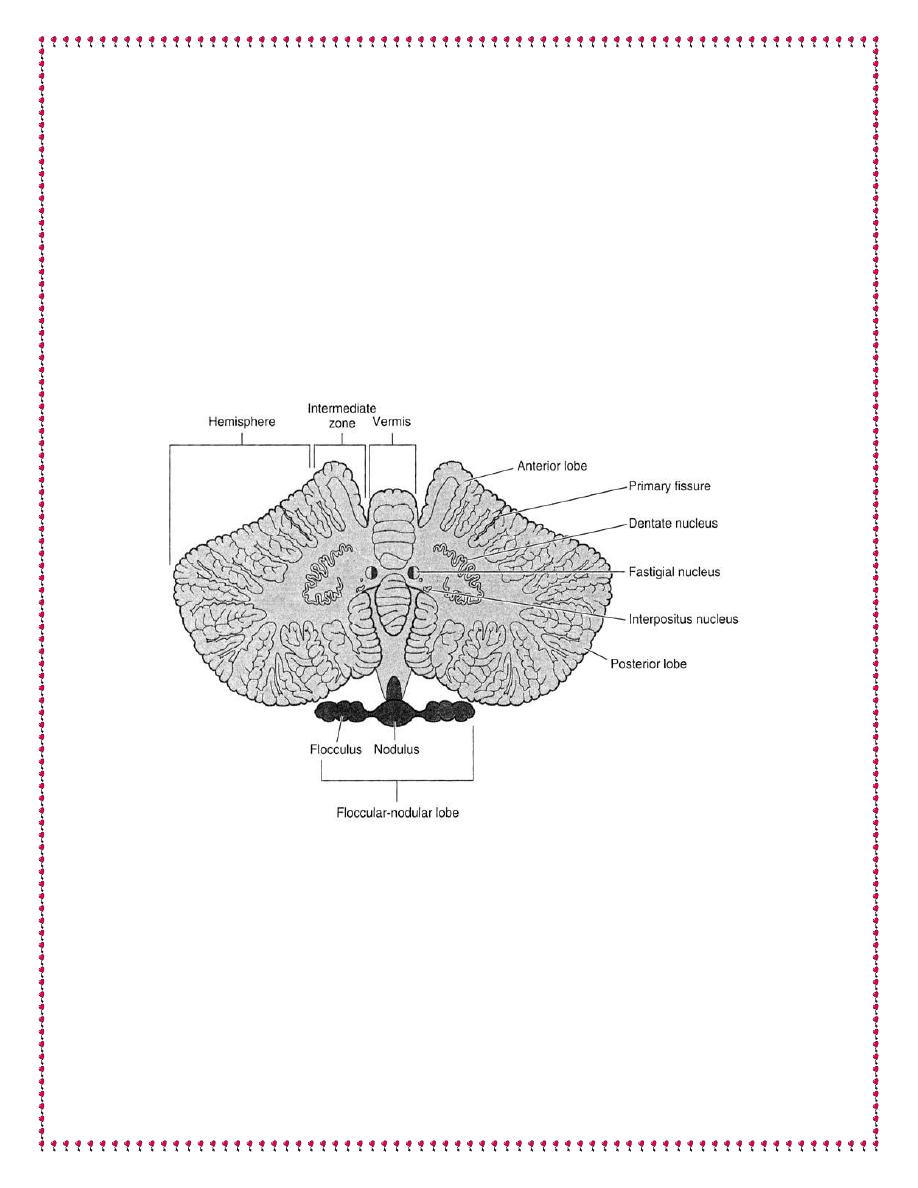
1
بسم هللا الرحمن الرحيم
Lecture 2- Neurophysiology Dr. Noor Jawad
2
nd
stage sunday
14/10/2018
………………………………………………………………….
Lobes of the Brain
Objective
1. What are the lobes of brain and its functions?
2. What is the cerebellum?
3. Nuclie of cerebellum,its location and functions?
The human brain is the most complex organ in the body. The brain
is divided into four sections, known as lobes .
1. Frontal lobe,
2. Occipital lobe,
3. Oarietal lobe,
4. Temporal lobe
Figure: show lobes of brain

2
Frontal Lobe
The Frontal Lobe of the brain is located deep to the Frontal Bone
of the skull.
It plays an integral role in the following functions/actions
Memory Formation
Emotions
Decision Making/Reasoning
Personality
Parietal Lobe
The Parietal Lobe of the brain is located deep to the Parietal Bone
of the skull
.
It plays an integral role in the following
functions/actions
Senses and integrates sensation(s)
Spatial awareness and perception
(Proprioception - Awareness of body/ body parts in space and
in relation to each other).
Occipital lobe
The Occipital Lobe of the Brain is located deep to the Occipital
Bone of the Skull .
Its primary function is the processing, integration, interpretation of
VISION and visual stimuli
.

3
Temporal lobe
The Temporal Lobes are located on the sides of the brain, deep to
the Temporal Bones of the skull.
They play an integral role in the
following functions:
Hearing
Organization/Comprehension of language.
Information Retrieval (Memory and Memory
Formation)
Cerebellum
The cerebellum (“little brain”) is part of CNS that is located at the
back of the brain, underlying the occipital and temporal lobes of
the cerebral cortex in posterior cranial fossa . It is a relatively small
portion of the brain -- about ten percent of the total weight, but it
contains roughly half of the brain's neurons, specialized cells that
transmit information via electrical signals.
The cerebellum has been considered a motor structure, because
cerebellar damage leads to impairments in motor control and
posture and because the majority of the cerebellum’s outputs are to
parts of the motor system.

4
Cerebellar gross anatomy
Anatomically, the cerebellum is divided into three lobes by two
deep fissures, : (1) the anterior lobe, (2) the posterior lobe, and (3)
the flocculonodular lobe been rolled downward from its normally
hidden position. Note, down the center of the cerebellum, a narrow
band called the vermis, which is separated from the remainder of
the cerebellum by shallow grooves. Most cerebellar control
functions for muscle movements of the axial body, neck,
shoulders, and hips are located in this area.
The cerebellar deep nuclei (or cerebellar nuclei) are the sole output
structures of the cerebellum. These nuclei are encased by a highly
convoluted sheet of tissue called the cerebellar cortex, which
contains almost all of the neurons in the cerebellum..

5
Figure show divisions of cerebellum
Function
The cerebellum is involved in the following functions:
1. Maintenance of balance and posture.
2. Coordination of voluntary movements.
3. Motor learning. The cerebellum is important for motor
learning. The cerebellum plays a major role in adapting and
fine-tuning motor programs to make accurate movements
through a trial-and-error process (e.g., learning to hit a
baseball).

6
4. Cognitive functions. Although the cerebellum is most
understood in terms of its contributions to motor control, it is
also involved in certain cognitive functions, such as
language.
Cerebellar nuclei
1. The
fastigial nucleus
is the most medially located of the
cerebellar nuclei. It receives input from the vermis and from
cerebellar
afferents
that
carry
vestibular,
proximal
somatosensory, auditory, and visual information. It projects
to the vestibular nuclei and the reticular formation.
2. The
interposed nuclei
: They are situated lateral to the
fastigial nucleus. They receive input from the intermediate
zone and from cerebellar afferents that carry spinal, proximal
somatosensory, auditory, and visual information.
3. The
dentate nucleus
is the largest of the cerebellar nuclei,
located lateral to the interposed nuclei. It receives input from
the lateral hemisphere and from cerebellar afferents that carry
information from the cerebral cortex (via the pontine nuclei).

7
4. The
vestibular nuclei
are located outside the cerebellum, in
the medulla. The vestibular nuclei receive input from the
flocculonodular lobe and from the vestibular labyrinth. They
project to various motor nuclei and originate the
vestibulospinal tracts.
figure show Cerebellar nuclei

8
Functional Subdivisions of the Cerebellum
The anatomical subdivisions correspond to three major functional
subdivisions of the cerebellum.
1.
Vestibulocerebellum
. The vestibulocerebellum comprises
the flocculonodular lobe and its connections with the lateral
vestibular nuclei. As its name implies, it is involved in
vestibular reflexes (such as the vestibuloocular reflex) and in
postural maintenance.
2.
Spinocerebellum
. The
spinocerebellum
comprises
the vermis and the intermediate zones of the cerebellar
cortex, as well as the fastigial and interposed nuclei. As its
name implies, it receives major inputs from the
spinocerebellar tract. It is involved in the integration of
sensory input with motor commands to produce adaptive
motor coordination.
3.
Cerebrocerebellum.
The cerebrocerebellum is the largest
functional subdivision of the human cerebellum, comprising
the lateral hemispheres and the dentate nuclei. In addition,
the cerebrocerebellum is involved in the cognitive functions
of the cerebellum
.

9
Thank you
References : Guyton and Hall textbook of medical
physiology, thirteen edition
